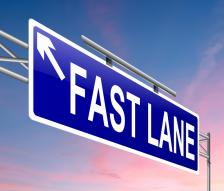What’s the Difference Between Speed and Velocity?
Speed and velocity are sometimes used differently in real life than they are in science. Ask Science discusses the differences and similarities between speed and velocity.
Lee Falin, PhD
Listen
What’s the Difference Between Speed and Velocity?
A while back, Grammar Girl and I discussed a few words that tend to mean something different to scientists than they do to most people. Today I want to discuss another group of terms that most people use in a way that’s different than their scientific meanings: speed and velocity..
The Need for Speed
Speed is a measurement of how far you go in a given length of time. Miles per hour or meters per second are both measurements of speed. Notice how both of those measurements are in the form “distance” per “time.” Anytime you see that form, you’re probably talking about speed.
There are two ways to think about speed: average speed and instantaneous speed. To figure out your average speed, you take how far you’ve traveled and divide it by how long it took you to do it. So if you walked 50 miles today and it took you just 5 hours to do so, you could say that your average speed was 50 miles per 5 hours.
Of course that’s a bit weird to say, so most people would simplify things by dividing both parts by 5 so that they could see the average distance traveled each hour. In this case you’d get a speed of 10 miles per hour.
Instantaneous speed tells your speed is at a particular moment of time. If you’re in a car, you can figure out your instantaneous speed pretty easily by just looking at the speedometer (speedometer literally means “speed measurer”). If the speedometer says 50 miles per hour, then your instantaneous speed at the exact moment you looked at it was (not surprisingly) 50 miles per hour.
If you don’t have a speedometer handy, then you can technically still figure out your instantaneous speed using calculus, but it becomes a bit trickier.
The Not-so-Handy Distance-Time Graph
As you might imagine, lots of things can impact your average speed. Let’s say for example that during that rather impressive 50 mile walk you went on earlier, you decided to stop after the second hour to take a little breather. As a result, during that second hour you only made it about 8 miles.
Just like one bad test score can pull down your average grade, covering less distance during part of your travels will lower your average speed.
One thing you can do to visualize these changes in speed is to use a distance-time graph. This is a graph where the distance traveled is plotted along the vertical axis while the time passed since starting your journey is plotting along the horizontal axis.
If you plot your distance every hour using this graph, you can draw a line between the points to see a visual record of how your speed changed over time.
I’m Not Victor…I’m Vector!

In science, velocity is the rate at which something’s position changes. In our walking example, the fact that you had a speed of 50mph tells us how fast you were going, but it doesn’t tell us anything about your position. Were you walking in a straight line, zig-zagging down the street, or going in circles? All of those scenarios have the same speed, but different velocities.
While speed is measured by distance traveled in a given amount of time, velocity is the displacement of something in a given amount of time. Velocity is what scientists call a vector quantity, which is just a fancy name for a measurement that includes both a number (or magnitude) and a direction.
So if you walked 10 miles north, and it took you an hour to do so, your average speed would be 10 miles per hour while your average velocity would be 10 miles North per hour.
Keep in mind that while speed measures how far you’ve traveled (your distance) in a given amount of time, velocity measures how far you’ve traveled from where you started (your displacement) in a given amount of time.
This seems like a subtle distinction, but it’s an important one. If on your walk you went north for half the time, then turned around and walked south the other half the time, your average speed wouldn’t change (assuming you walked the same speed both ways), however your average velocity for the trip would be zero. That’s because since your final position was the same as your starting position, your displacement was 0.
That’s it for this week. If you have a question you’d like to see on a future episode, send me a message at everydayeinstein@quickanddirtytips.comcreate new email, or via Twitter at @QDTEinstein.
Racecar or Spaceship image, Ricky Flores’ photostream at Flickr. CC By 2.0.


